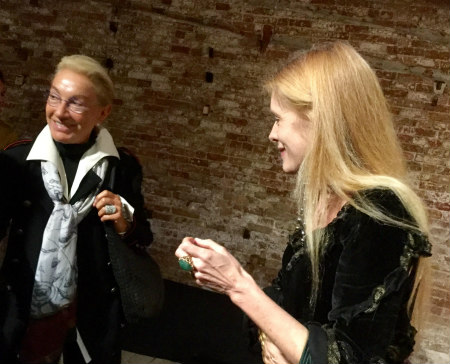 |
| Adam, Mars & Eve by Antonio Rizzo - Photo: Cat Bauer |
For centuries, they had adorned the Foscari Arch outside in the courtyard of the Doge's Palace opposite the Giants' Staircase, the official entrance to the palace, also designed by Rizzo. The weather in Venice was corroding their bones.
As the years ticked by, the white marble turned to black due to atmospheric pollution. Fingers and toes cracked. Adam broke an arm. At the beginning of the 20th century, Eve was brought inside and replaced by a bronze copy. After World War II, between 1953 and 1955, Adam and Mars were also replaced. The originals were better off inside but they still were black and broken.
As the years ticked by, the white marble turned to black due to atmospheric pollution. Fingers and toes cracked. Adam broke an arm. At the beginning of the 20th century, Eve was brought inside and replaced by a bronze copy. After World War II, between 1953 and 1955, Adam and Mars were also replaced. The originals were better off inside but they still were black and broken.
 |
| Peter Marino & Toto Bergamo Rossi Photo: Cat Bauer |
Enter art restorer Toto Bergamo Rossi, the Director of Venetian Heritage, a non-profit organization dedicated to safeguarding the cultural legacy of the Venetian Republic. Bringing the marble trio back to their former glory became one of his missions.
Toto spoke to the American architect, Peter Marino, the new Chairman of Venetian Heritage and said they would need about €225,000. Peter was convinced that the restorations were vital after Toto told him that Adam & Eve were the first nude free-standing public statues in the Republic of Venice.
The restoration team was headed by Jonathan Hoyte, an American restorer. When I first saw Jonathan at the presentation on Friday, October 25, I recognized him immediately -- he had been part of the first Cleaning Day in Venice in 2012 when a group of volunteers organized by Masegni & Nizioleti removed graffiti from a building off Strada Nuova. I told him I didn't realize back then that he was a professional!
Jonathan said that the statues were black because of pollutants and previous restoration treatments -- there were even remnants of wax from when the plaster molds to create the replicas were made -- and that they had tried several methods to remove the grime.
 |
| Jonathan Hoyte & Peter Marino - Photo: Cat Bauer |
Jonathan said that the statues were black because of pollutants and previous restoration treatments -- there were even remnants of wax from when the plaster molds to create the replicas were made -- and that they had tried several methods to remove the grime.
They finally settled on a laser treatment, the type they use to remove tattoos. It is astonishing how the laser removed the black layers, restoring the precious Carrara marble to a beautiful sheen.
The statues looked so impressive standing there in the Sala dello Scrutinio, the great hall where elections were held during the Venetian Republic, that Gabriella Belli, the Director of Venice's Civic Museums, said that there is where they will stay.
So not only did Adam, Eve, and Mars get complete makeovers, but they also got grand new lodgings -- another reason to visit the Doge's Palace.
 |
| Cleaning Eve - Photo courtesy Venetian Heritage |
 |
| Sala dello Scrutinio, Palazzo Ducale, Venice - Photo: Cat Bauer |
Thank you Venetian Heritage for bringing the statues back to life. Go to Palazzo Ducale for more information.
Ciao from Venezia,
Cat Bauer
Venetian Cat - The Venice Blog
Ciao from Venezia,
Cat Bauer
Venetian Cat - The Venice Blog







